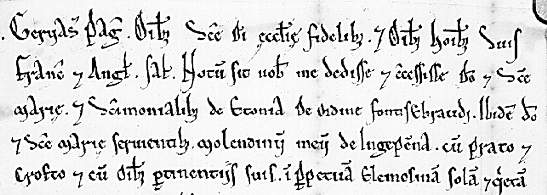Script Type : minuscule
Alternative Name : transitional Gothic document hand
Date : 12th century
Location : England
Function : Document hand or charter hand

























Distinctive letters : Document hands of the 12th century were somewhat varied as the standardisation of Caroline minuscule gave way to experiments with the more angular forms which came to be called Gothic. This example is of a rather spiky variant and some letters, such as p and h, have extravagant angles. The letter forms are not entirely uniform and great effort went into choosing the exemplars shown here.
The trick letters are a and q. The letter a has a lavish curl at the top, making it look a bit like a d. However, that has a rather different form. The descender of q curls to the left, making ot look like a g. However, g has a much more extravagant shape.
As with Caroline minuscule from which it derives, there are two forms of r, one a very simplified form. The letter s is usually tall although the short and curly form is present and t is short.
There are some variants which look like capitalised forms, although they are not enlarged. For example
 this form of m and
this form of m and  this form of U with a looping descender.
this form of U with a looping descender.
As is not uncommon in Gothic scripts, the second i of a double i can be extended down, as in the following word
![]() pertinentiis (abbreviated).
pertinentiis (abbreviated).
As usual, there is no k, y, z or j, but the letter w appears. It is not found in Latin, but it occurs here in English names in the list of witnesses to the document.
The text is heavily abbreviated, and part of the trick of reading it is that it follows a fairly standard charter formula, or diplomatic. That is to say, you have a pretty fair idea of what most of it is about before you get into the niceties of reading every letter. Run the cursor slowly over the first few lines of text to get the general idea. For a more detailed examination of the document, proceed to the paleography exercises.
Paleography
exercises using Flash![]()
Requires at least the Flash 5 plugin
If you are looking at this page without frames, there is more information about medieval writing to be found by going to the home page (framed) or the site map (no frames).